Art, Technology, Crisis: The Work of Carl Cheng
Do you have everything you need? An alabaster carrying case, sides reinforced with grommets, tempts with an offer of such plenitude. This chipper frustum is Carl Cheng’s (b. 1942) Emergency Nature Supply Kit (E.N. Supply, No. 271-OJ) (1971; fig. 1). Inside the kit is not the whole world, but rather a synecdoche for it: a miniature patch of grass, a recording of birds, and a mordant accompanying film depicting the ominous future for which such a kit prepares. In the film, a woman dressed in a lustrous vinyl jumpsuit transports her own kit through the underground warren of Osaka’s mass transit system (fig. 2). Her eyes are obscured by hexagonal sunglasses; her mouth and nose are covered by a respirator mask; her hands are sheathed in gloves. She is protected—or, at the very least, protective.

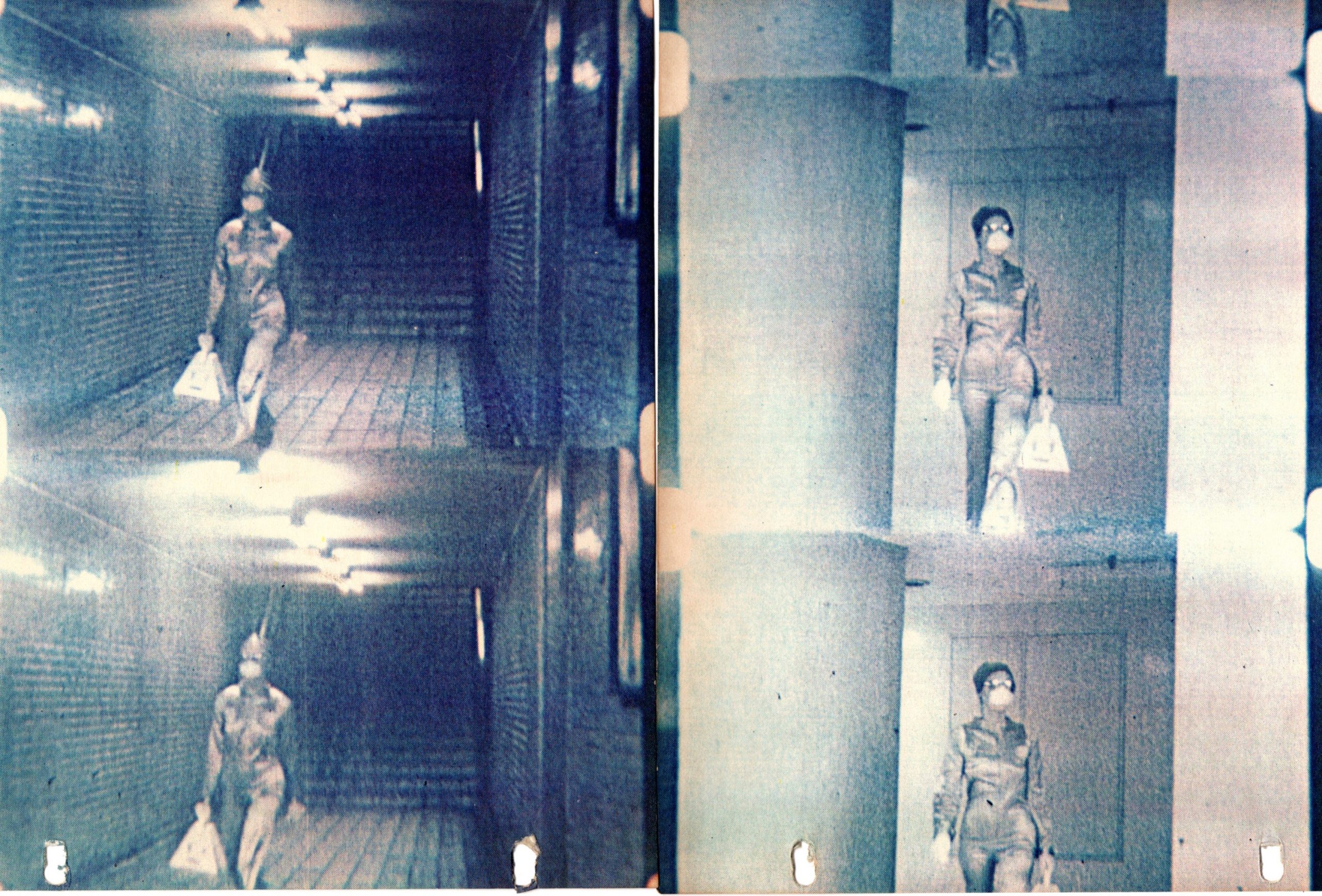
Cheng’s title is as officious as it is quixotic. The alphanumeric identification points to the object’s seriality—it is one among others—as well as to the larger infrastructure of inventory, storage, and retrieval that a high volume of product necessitates. Its fussy repetition (“Emergency Nature,” immediately condensed to “E.N.”) illuminates one of modern capitalism’s many paradoxes, wherein strategies designed for efficiency result in time-consuming bureaucratic redundancies. Moreover, although nominally labeling the product, the designation avoids specifying the conditions for its use. What might constitute the emergency—nuclear winter, typhoon, contagion, apocalypse—is left unnamed and, perhaps most terrifyingly, to the imagination.
Whatever the imminent catastrophe, this object’s capacity to protect is suspect. What beyond the thinnest of comforts—nostalgic reminders of a world gone by, in which birds still sing and grass still grows—could E.N. Supply ever provide? The contents inside offer neither food nor shelter, nor tools for survival. Rather than assuage, this object taunts.
Perhaps derision is the point. E.N. Supply is at once a product for sale by the John Doe Company and a sculpture by the artist Carl Cheng, doing business as the John Doe Company. In this, the work illustrates both Theodor W. Adorno’s diagnosis of the autonomous art object’s “guilty” self-reflection about its inefficacy and Sianne Ngai’s incisive rebuttal: that “bourgeois art’s reflexive preoccupation with its own ‘powerlessness and superfluity in the empirical world’ is precisely what makes it capable of theorizing social powerlessness.”1 Just as the kit manifests apotropaic desire, it operationalizes that desire’s frustration through inefficacy, or even impotence.2
Cheng’s works of the late 1960s and early 1970s enact many of the key procedures for which the period’s art is best known: mobilizing newly available industrial materials, turning to processes of organic transformation, engaging theories of systems and ecologies, manipulating the work of art’s relationship to the commodity form, and interrogating the exhibition’s discursive power and conditions of display. Yet Cheng’s works displace the familiar coordinates orienting art-historical accounts of these transformations; they do so, I argue, in ways that speak to modernity’s processes of Asian American racialization.3
As in E.N. Supply, a preoccupation with nature has anchored Cheng’s oeuvre, with deleterious effects on its reception. In 1991, Michael D. Hall summarized the ways a Chinese American artist working with both organic and technological materials had been reductively interpreted as staging a confrontation between Occident and Orient. Cheng, in Hall’s words, became an “object of a cultural fantasy” through which:
Eastern philosophy is supposed to provide a moral corrective for the moral transgressions perpetrated by western hubris. In this fantasy, Cheng is ordained to re-sensitize culture where meditation and macrobiotics failed. Cheng, as a fantasy Zen priest named John Doe, is supposed to walk across the rice paper of post-modernism and leave no trace—an exercise that both points up and purges the foibles of late capitalism.4
Yet the antinomies between which Cheng worked were not those of east and est, but rather art and industry. Cheng’s early career was spent in the crux of the two, having studied industrial design as an undergraduate; spent time at the Folkwang School of the Arts in Essen, with its Bauhaus-inflected curriculum; and briefly worked for Charles and Ray Eames.5 In between, Cheng took his master’s degree at the newly formed photography department at the University of California, Los Angeles, helmed by Robert Heinecken.6
As is well known, the late 1960s historical conjuncture featured an ever-narrowing gap between art and technological industry. Much has been said about its gendered dimensions: the ways that Minimalist sculptors, in Anna C. Chave’s foundational analysis, “availed themselves” of industry and technology’s “cultural authority.”7 The artist Robert Morris later reconsidered the milieu’s self-fashioning as “industrial frontiersmen,” in which the masculinist fantasy that the “artwork must carry the stamp of work—that is to say, men’s work, the only possible serious work, brought back still glowing from the foundries and mills without a drop of irony to put a sag in its erect heroism” reigned supreme.8
Significantly less has been said about the racialization of this rhetoric, unmarked and coded as white.9 Lisa Lowe clarifies the ways that the US nation-state continuously produces the Asian American as a means of “resolving economic exigencies” about the disciplining and management of labor.10 Colleen Lye elaborates to demonstrate that the twinned stereotypes of Asians as either “yellow peril” or “model minority” has been vested through a central, persistent trope of “economic efficiency,” which, in different historical moments, grounded arguments about exclusion in the former context and assimilation in the latter.11 In both cases, the engine driving such characterizations are “predictions of Asian productivity supplanting European [or American] dominance.”12 Laboring Asian bodies, in the United States and elsewhere, have long been cast as having an unusual capacity for economic modernity.
That very modernity, as both resource and phantasm, suffused the period’s artistic discourses: from Jack Burnham’s championing of a “systems esthetic” to the Experiments in Art and Technology (E.A.T.)’s collaboration with Bell Laboratories engineers and Maurice Tuchman’s Art & Technology initiative at the Los Angeles County Museum of Art (LACMA).13 Cheng was informally enmeshed with the E.A.T. crowd; the Emergency Nature Supply film is set in Osaka because Cheng traveled there to join E.A.T. artist friends participating in the infamous Pepsi Pavilion at Expo ’70—E.A.T.’s first major international commission, which resulted in a terminated contract.14 However, when invited to join Tuchman’s project—which partnered individual artists with industrial corporations—Cheng declined.
Art & Technology (A&T) modeled a two-way transfer between artist and institution: in exchange for access to materials and fabrication facilities, artists lent their cultural capital and veneer of avant-garde prestige. Given his experiences in industrial design and technical expertise, Cheng felt he did not require such an introduction, premised on the subordinated role of artists in relation to the corporate firms.15 Disinterested in joining the star-studded artist roster, dominated by those from the east coast descending on Los Angeles, Cheng also perceived the enterprise to be “superficial,” and “all about style.”16 In his words, Tuchman’s project was one of “the art world learning to use tools.”17 Cheng’s critique, which moves dialectically not only toward industry but also back at art, finds its most cogent articulation in his work. Rather than partner with a corporation, Cheng became one.
In 1967, Cheng formed the John Doe Company.18 To incorporate was not solely to rebuff the A&T project; it no doubt reflects a familiarity with the Duchampian conceptual tradition.19 Yet, by filing as a corporation, that is, “doing business as” the John Doe Company, Cheng did not so much reject the authorial power of the artist as inscribe it further into the capitalist juridical system. Moreover, contra Duchamp’s exaggeratedly playful and cheeky sobriquet of “Rrose Sélavy,” Cheng’s “John Doe” does not so much détourn language to new ends as mimic a decidedly institutional glossary. Where “Rrose Sélavy” is a homonymous celebration of desire and living (eros, c’est la vie), “John Doe”—the placeholder used by law enforcement to refer to corpses whose identities are unknown—parrots a carceral regime’s approach to death.
Conceptually dexterous, the John Doe Company (hereafter JDC) was also, in Cheng’s telling, deeply practical, at once the suggestion of his accountant and a means to facilitate querying manufacturers about certain industrial materials. Though the objects produced by the JDC were made by the artist’s own hand, in this period, Cheng frequently worked in series, modest economies of scale. Often stamping his sculptures with brand identification, Cheng also began producing promotional literature and product reports. Consider an invitation to his 1970 solo exhibition at the Esther Robles Gallery, which functions doubly as something like a mail-order catalogue (fig. 3).20 In part, it reads:
JOHN DOE COMPANY
invites you to an exhibition of new products
by
CARL CHENG
Here, the dual articulation of the artist’s author-function and its ensuing subsumption into corporate anonymity is made definite, with the generic façade of “John Doe” as an unmarked, and therefore implicitly white name, placed in contrast to Cheng’s explicitly Asian surname.21 Moreover, the catalogue elides the—ongoing, if often out of view—profit-seeking labors of the gallery with that of manufacturing sectors, making the former’s commercial ambitions all the more evident in ways conversant with Conceptual art’s “aesthetics of administration” and especially the public-relations activities of dealer Seth Siegelaub.22 Yet, in contrast to the rigorous elimination of visuality that came to be known as Conceptual art’s hallmark, Cheng remained committed to making objects and always furnished his sculptures with opportunities for spectatorial delight and visual pleasure.


The gratifications of looking dilate in Cheng’s series of Specimen Viewers. Burlesquing industry’s common argot, the exhibition announcement-cum-product catalogue advertises a Table Model Specimen Viewer both with elements that can be reasonably cast as luxury components (“built-in light switch, removable dust cover”) and with those that smirk wryly at the concept of a “feature” itself (“internal designed planned obsolescence”). The object’s slick look belies its bespoke nature (“8 specimens especially selected for Viewer”). In the catalogue, it appears as a bright tangerine-colored form in front of a black-and-white image of a woman (Felice Mataré), who is rendered anonymous, her face cast in darkness. Her open blouse frames the enlarged Specimen Viewer; its viewing platform is centered directly between her exposed breasts. She seems to fix her gaze on the specimens before her, just as the viewer is encouraged to fix their gaze on her body, rendered an erotic specimen (fig. 4).23
In this way, the advertisement both exploits and winks at the visual consumption of the female body, which is tantalizingly on offer for an experience of looking made analogous to the pleasures of touch. The Specimen Viewers are deliciously sci-fi objects, inviting optical and tactile delight (figs. 5 and 6). The removable dustcovers are primarily made of an enticing cerulean Plexiglas; they simultaneously protect the Viewers themselves and play a coy visual game, obscuring the interior forms. In their hard-edged contours, these clamshell cases conjure the iconic Minimalist cube. Inside, the plastic forms, in admixtures of neon chartreuse and cadmium reds and yellows, recall the candy shell coating of West Coast Minimalists known for their so-called “Finish Fetish” aesthetic.24 The voluptuous inner forms are reminiscent of both a typewriter and a slide projector, rendered in alien ooze. Roughly cuboid and bulbous, each features a niche into which several specimen “slides” can be stacked. On top, a round pedestal is kitted with a slide-in frame into which an individual specimen slide can be neatly slotted for viewing, and a light switched on to spotlight it. The Viewers, set inside their cases, seem to float supernaturally. When the bivalve case is opened, each is presented like a hard-won pearl.
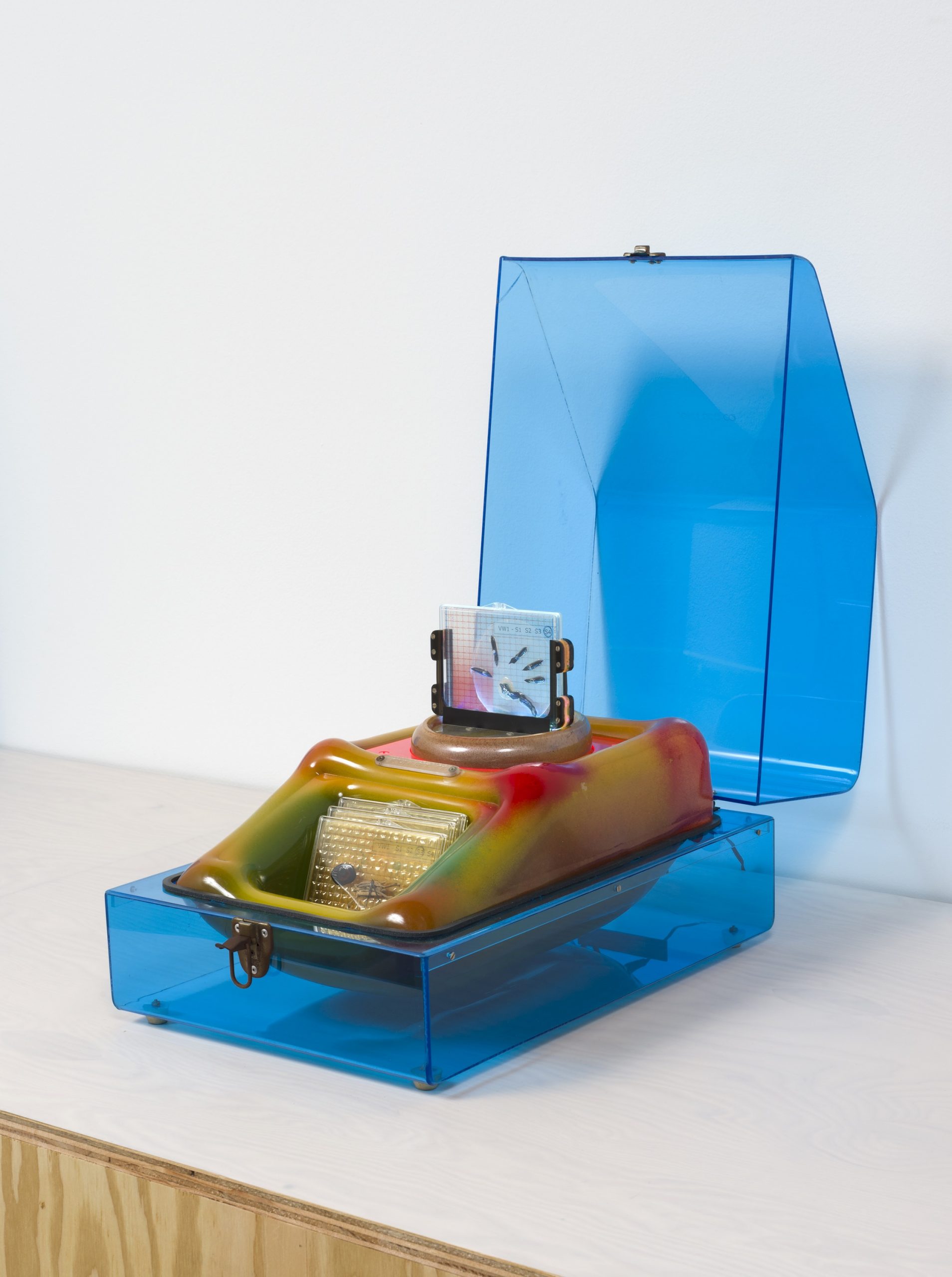
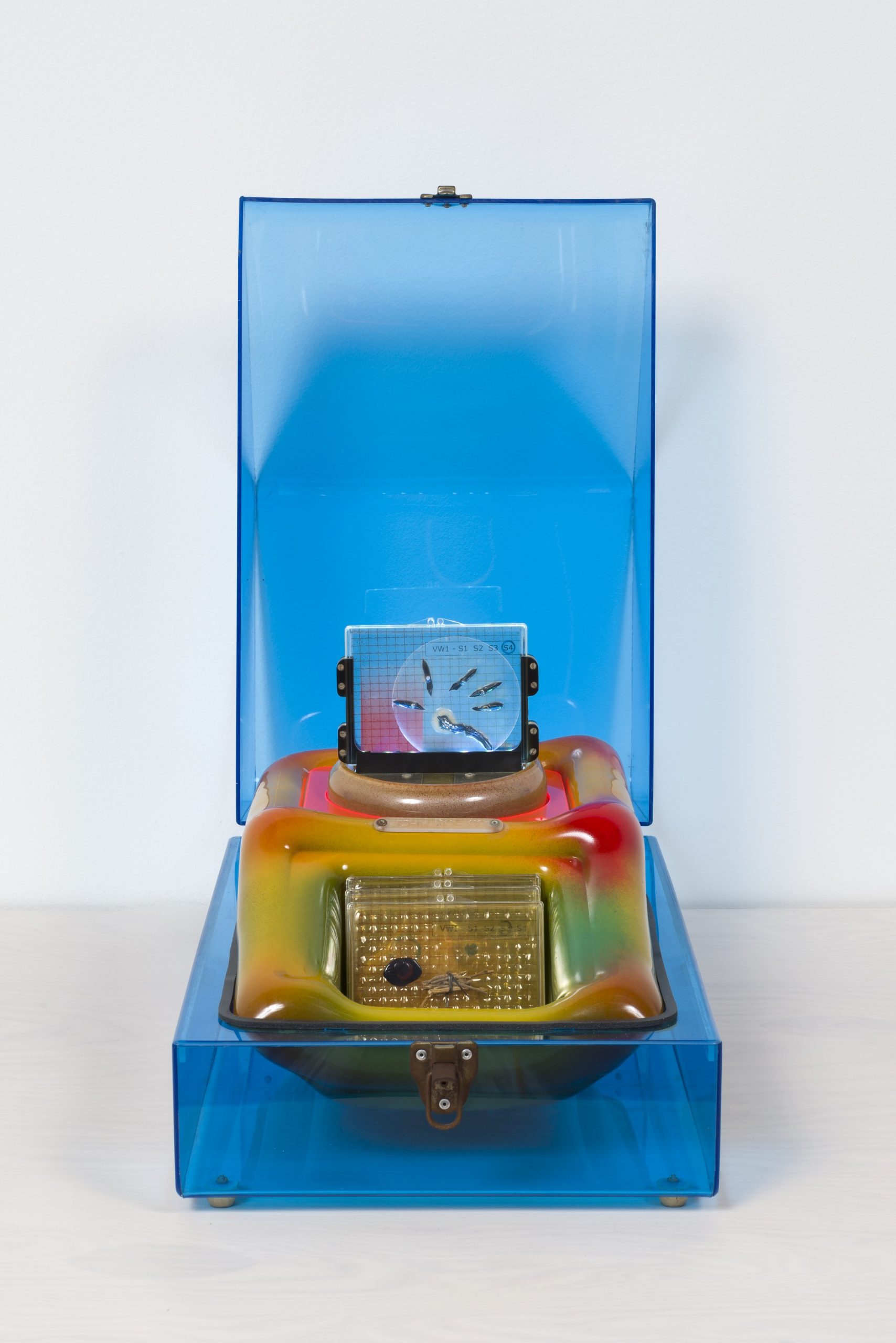
For all their visual pleasure, Cheng’s Specimen Viewers engender an experience not only of delight but also disorientation. The industrial materials with which 1960s sculptors and their audiences were so enamored—resins, polymers, acrylics, and plastics among them—enabled vertiginous experiences of perceptual confusion, rendering distinctions between line and plane or volume and shadow tantalizingly difficult to parse, qualities that led Rosalind Krauss to describe Donald Judd’s works as “adumbrated and misleading.”25 While conversant with Minimalism’s formal vocabularies, Cheng’s sculptures differ markedly from those of not only Judd but also West Coast artists such as Craig Kauffmann, John McCracken, Helen Pashgian, and Fred Eversley—and especially from the perceptual environments of Maria Nordman, with whom Cheng and Pat O’Neill shared a studio building—because they return the Minimalist object, almost vehemently, to the realm of proposed “function.”
Nearly all of Cheng’s sculptures cannily employ what, in 1966, James J. Gibson termed “affordances,” those components that suggest, by their form, how users should engage them: latches that invite opening, knobs turning, handles carrying.26 The Specimen Viewers solicit the opening of the case and the placement of a slide on the viewing platform. The next steps are less clear. Each of the specimens, with its own slide case, seems to contain biological samples: small insects, twigs, and other organic matter, field samples gathered during trips to Osaka and Indonesia. They resonate as various “specimen” acquisitions, both human and nonhuman, enabled by colonial exploration and conquest. Yet closer inspection reveals still more alien forms, additional organic shapes rendered in gobs of paint, resin, or wax (fig. 7). Thus, the Specimen Viewers, despite their high-tech appearance, ultimately offer relatively few “features” other than an invitation to aesthetic contemplation. With neither a microscope nor a viewing lens to aid the eye and enhance its capacities, there is, in fact, nothing—other than a light—to amplify perception. There is only a baroque presentational apparatus made specifically for the viewing of daubs of paint and other artistic materials: a theatricalization of beholding itself.
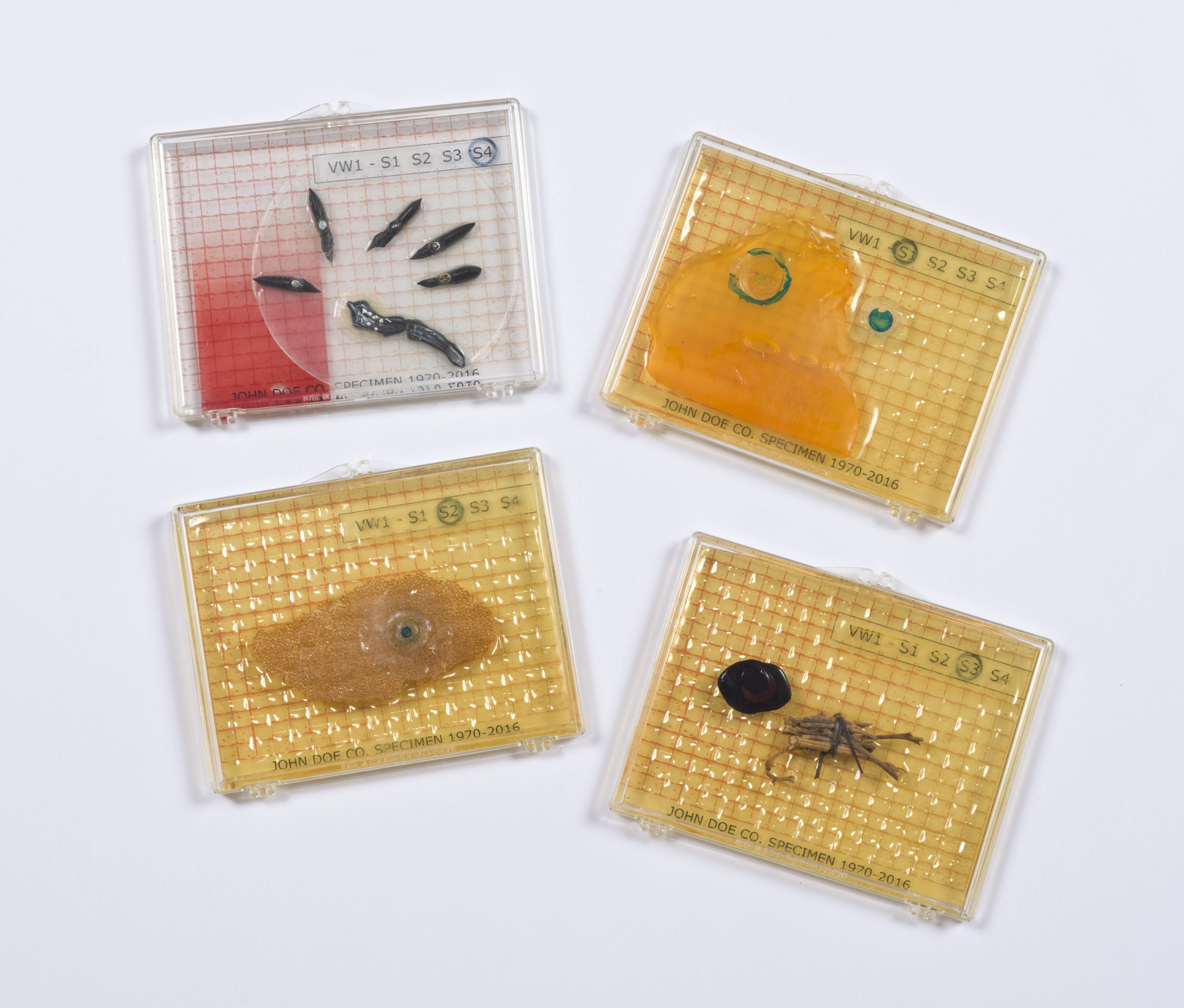
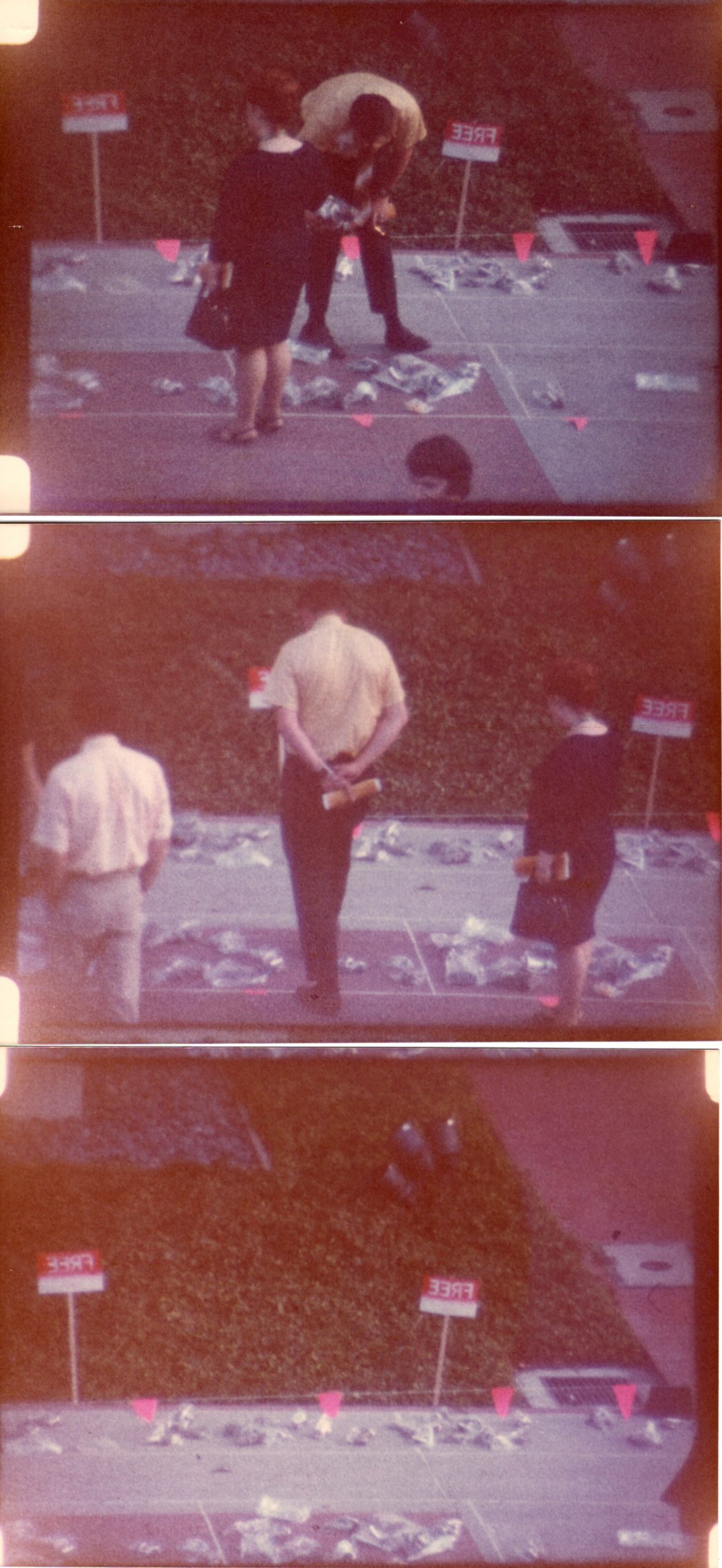
If Cheng’s forms purposefully evoke the Minimalist sculpture then at the height of its fame, his work also participates in what would come to be called Institutional Critique, what Craig Owens would name a groundswell of movement from “work to frame,” and Robert Smithson would identify as the “investigation of the apparatus the artist is threaded through.”27 In 1968, for example, the University of Southern California hosted an Art and Technology Festival. Cheng characterized his participation this way: “Un-invited artist took part in ‘USC Art and Technology Festival’ by placing 2000 lbs of exotic technology along walkways with ‘free’ signs posted. All items were packaged with John Doe Co. Labels.”28 Photographs of the unsanctioned event in Cheng’s archive are mostly shot from a distance, subjects captured unaware. One man clasps his hands behind his back; in another frame, he bends at the waist to get a closer look. These are familiar postures of the gallery-goer or museum visitor (fig. 8).
However, Cheng’s presentation was less in the mode of an exhibition than that of a bazaar, yard sale, or informal street vendor, with tinges of a construction site or crime scene. See the strung-up flags, orange wedges interrupting the hedgerows; or the chalk outlines on the pavement, mere suggestions of a vitrine; or the red signs announcing “free,” with their spindly posts struck into the ground, rather than crisp didactic labels. Closer shots capture small plastic baggies, each carefully tagged, featuring a bevy of microchips, sprockets, and wires (fig. 9). If these technologies were, in Cheng’s words, “exotic,” their otherness inhered not because they hailed from an unfamiliar elsewhere (as in the orientalist and primitivist accumulations his word choice evokes), but rather because their functions might not be legible to the lay viewer: an alienating experience of “art” made akin to that of the unhandy at the hardware store.

Cheng’s technology giveaway is something of the readymade in reverse. Duchamp goes shopping and places a urinal or bottle rack in the galleries, demonstrating that art’s definition is not ontological, but rather contingent on an institution and its language. At USC, the tech on offer was at once itself, “technology,” and at the same time “art,” a potent doubling given the separation assumed by the festival’s title, with its telling conjunction (“Art and Technology”). Cheng, moreover, set his “exotic” technology’s price neatly at zero, in sharp contrast to the festival’s showcase of costly innovations. As a result, Cheng recalls that offerings were quickly “cleaned out.” (In this, they perhaps conjured other protests against the commodity form, such as the 1965 Watts uprisings, in which many engaged in the spontaneous, but nonetheless politically cogent, act of collective price-setting known colloquially as looting.) In other moments, Cheng attempted the opposite tack, making several of his interactive sculptures, some of which were installed publicly, “coin-operated.”29 In the latter experiments, it was Cheng’s supposition that having paid would enhance the viewer’s commitment to the aesthetic experience.30 In both cases, Cheng queries how economic expressions of value—such as those of “price”—might shape viewers’ judgments of the objects’ aesthetic value.
Shortly thereafter, Cheng began to work on a series of Art Tool Paint Experiments. They too dramatize their conditions of display through kits or cases that must be opened to reveal their inner workings. In contrast to the Plexiglas and plastics of his other works, the Art Tools are nestled in wooden boxes furnished with handles for carrying (some in a luxurious leather). All are emblazoned with the John Doe Company label. Art Tool Paint Experiment, Paint Dipper Display Box, for example, opens like a briefcase. Inside, the constituent parts are nested in a protective suede, each component in its own perfectly contoured resting niche (1972; fig. 10). The tool requires assembly; once put together, it can be set atop the case, which then acts as a pedestal (fig. 11). The effect is that of a traveling salesman’s theater, mixed with the intimacy of the hobbyist’s personalized kit. In each of the Art Tool Paint Experiments, pigment extrudes around spinning discs or down chutes. Their simple machines (wheel, inclined plane) culminate in mechanized abstractions and curdled drips. If the machine repeats its operations enough—seemingly without limit—it creates ever sludgier gobs of paint, in some instances revolting admixtures of brownish pinks and unctuous impasto. Looking at the results, one feels somewhat duped.
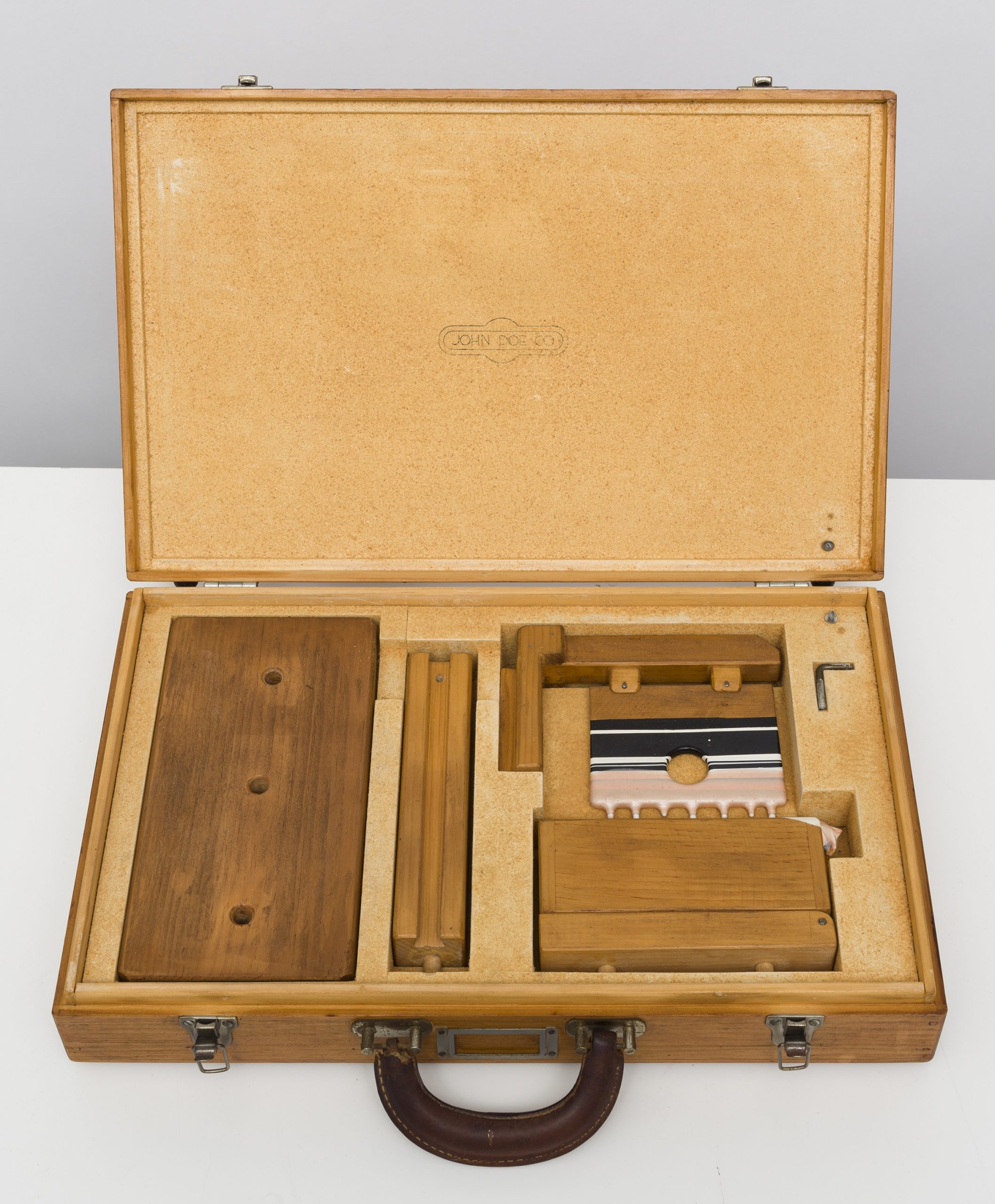

Absent the sleek materials characteristic of Minimalist sculpture, the Art Tool Experiments jab at that post-Minimalist shibboleth, “process.”31 They are perhaps most concisely described as knowing gimmicks. The gimmick, as theorized by Ngai, is a specifically capitalist phenomenon. Its primary function is that of abbreviation: it saves time, reduces labor, and cheapens value. To name something a gimmick is to express an ambivalent aesthetic judgment (it is both “wonder” and “trick”), in which the object’s capacity to enchant is immediately superseded by feelings of distrust, aversion, or a sense of fraudulence.32 Affective elation is followed by its consequent puncture; aesthetic pleasure deflates. The gimmick yokes a determination of negative aesthetic worth to one of low or negative economic worth; that is, its cheapness. Similar operations suffuse Erosion Machine No. 4, an acid-yellow appliance that pummels various stones with water until, like the results of a sculptor’s subtractive chiseling, they transform into new shapes (1969; fig. 12).33 In the erosion compartment on the right, an individual rock receives its violent bath. Other rocks sit patiently on metal racks in the left compartment, like scones cooling after a bake. Like Cheng’s Art Tools and Specimen Viewers, the Erosion Machines are “overrated” devices, easily judged to be both “working too little (labor saving tricks) but also as working too hard (strained efforts to get our attention).”34 In its unease about labor, time, and value, the gimmick, Ngai suggests, raises those very questions to which all “art under conditions of capitalist production” is subject: “Why so much exertion for a nonproductive activity?”35

In Cheng’s hands, such interrogations are vectored toward not only comedic effect but also ominous threat. In Early Warning System Model No CF 163, a plinth of acrylic plastic supports a smaller, three-layer cruciform stack (1969; fig. 13). An antenna sprouts from one side, its cord visible through the cube’s translucent planes, tracing down and out the sculpture’s bottom. It is a complex device: a radio is tuned to short-wave maritime channels, to which a light is, in historically specific and uncomfortably resonant technological terminology, “slaved,” such that it pulses in accordance with the signals.36 Two projectors emit a collaged film with scenes of human-made waste and oceanic views; like a lighthouse, they turn continuously. In the JDC catalogue, scale is distorted such that the Early Warning System looks like a massive piece of infrastructure installed on the side of a hillcrest like a watchful, imposing sentinel (fig. 14). Like E.N. Supply, the Early Warning System is stuffed full of portent but offers few answers. Of what coming catastrophe does this object warn? In the end, the collaged film, seen obliquely through layers of plastic, reveals almost nothing; any message sought in the flashing light is indecipherable. Yet again, a dazzling display of technological virtuosity is marshaled toward an opaque result. The warning is perhaps not of a singular, instantaneous catastrophe, but rather—like the weather itself—something more chronic; an ongoing crisis, its ravages undetected precisely because they are ordinary, happening every day.


For all their seeming obsession with the biotic, Cheng’s sculptures of living systems and specimens demand that one keep in mind the ways the management and maintenance of life is always already entwined with necropolitical adjudications of death.37 As Cheng crafted his darkly observant sculptures, imperialist violence in Vietnam waged on, and he was far from alone in his critique of art’s collusion with industry. Many would interrogate the ethics of working with such firms as Kaiser-Steel, Disney, Hewlett Packard, RAND Corporation, and Lockheed, whose products contributed, either directly or indirectly, not only to what we would today call climate catastrophe but also to the US invasion of Vietnam. In 1971, Max Kozloff called the A&T project a “Multimillion Dollar Art Boondoggle” in the pages of Artforum. That same year, Richard Serra (an A&T participant), delivered his own caustic diagnosis, saying that “technology is what we do to the Black Panthers and the Vietnamese under the guise of advancement in a materialistic theology.”38 By 1980, Burnham himself would describe “art and technology” as “the panacea that failed.”39
Such positions might be described as techno-skeptical rather than techno-utopian. Cheng, far from alone in this perspective, uniquely embedded this critique into his work. His artworks are often hilariously impotent machines or tantalizingly deceitful gadgets; they plait invocations of lurking threats and invitations to look as a gratifying mode of leisure. Taken together, Cheng’s oeuvre from this period mobilizes Minimalist forms and materials as well as conceptual plays with authorship and distribution; post-Minimalist engagement with systems and material change; and Institutional Critique’s concerns about the conditions of exhibition and display. It would be easy to make a case for their importance on the basis of familiarity—as annotations on canonic art histories of the period—or to suggest that they are easily accommodated into existing narratives: riffs on a familiar variation. I would like to consider them outside a framework of assimilation, not for their similarities to dominant artistic movements, but for their differences.
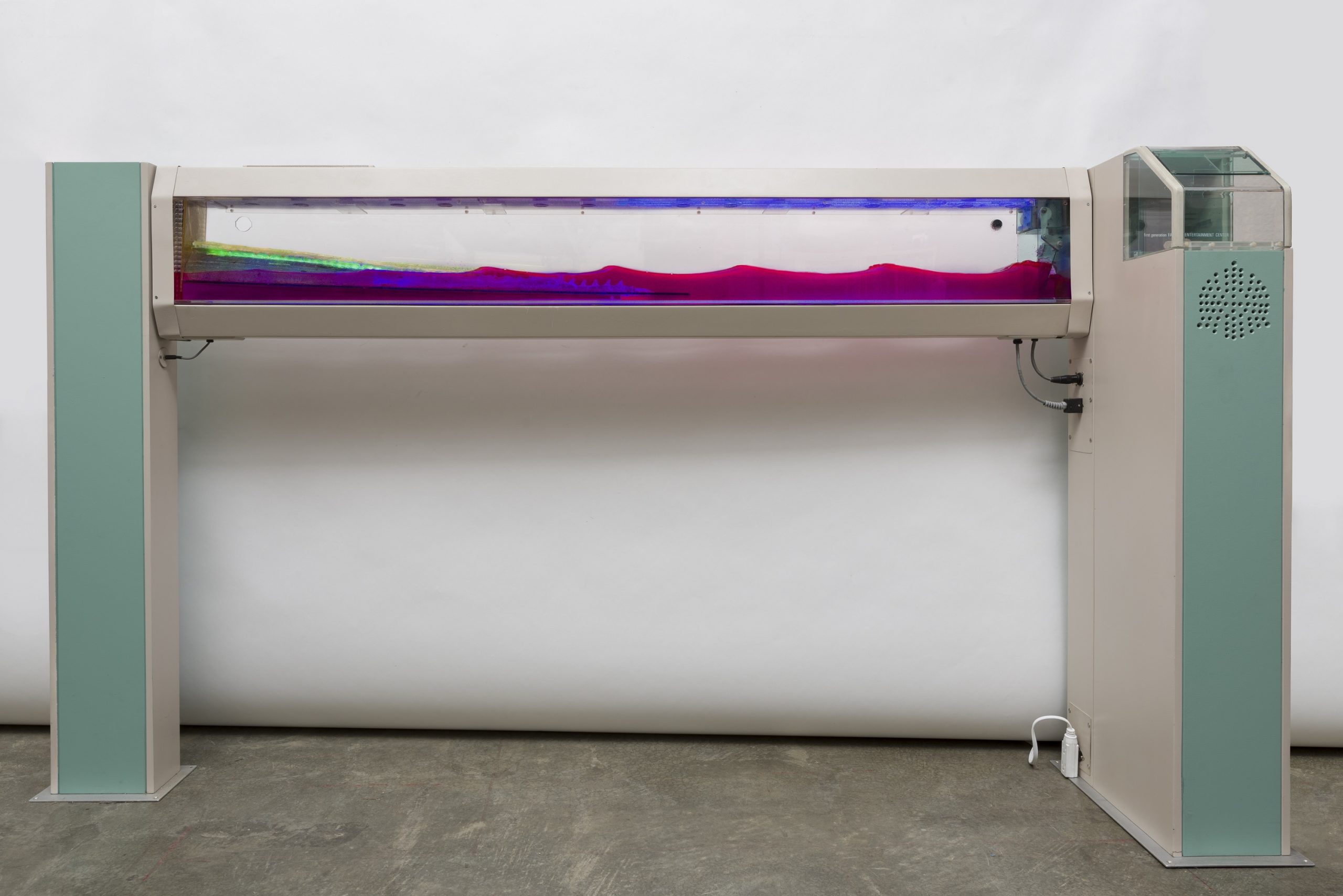
To repeat an old question: what difference does difference make? Consider First Generation Family Entertainment Center, an extended vitrine filled with colored water, mechanically manipulated to move in a series of abstract wave patterns (1968; fig. 15). In the 1970 catalogue, Mataré lounges on the sand in a bikini and the sculpture looms behind her, its “man-made” waves a visual substitution for those expected on the horizon line (fig. 16). The sculpture’s title is one of only a few oblique mentions of “identity” or race in Cheng’s work, and the object itself is perhaps best understood as a parodic sendup of integration or assimilation. In one photograph, Cheng stages the Entertainment Center in the middle of a room furnished with middle-class trappings. Instead of the cathode ray tube’s bluish light, the entire scene is crimson, as if drenched in blood (fig. 17). The television set is, of course, the ür-object of US postwar consumption, of which the heteronormative nuclear family is the foundational unit. With the rhythms structured by the Fordist family wage and the forms of leisure that wage enabled, television was emphatically privatized, neatly contained within the domestic space of the home. What’s “on” on Cheng’s Entertainment Center are not sitcoms or the evening news but only abstract wave forms. A soundtrack, comprising both field recordings and later, generic samples, features what the artist calls “participation sounds” — fans cheering at a football game, pins crashing at a bowling alley. Television is a site for the satiation as well as the production of desire; for the artist, the work probes “what a person needs when they watch TV . . . you want something to participate in.”40

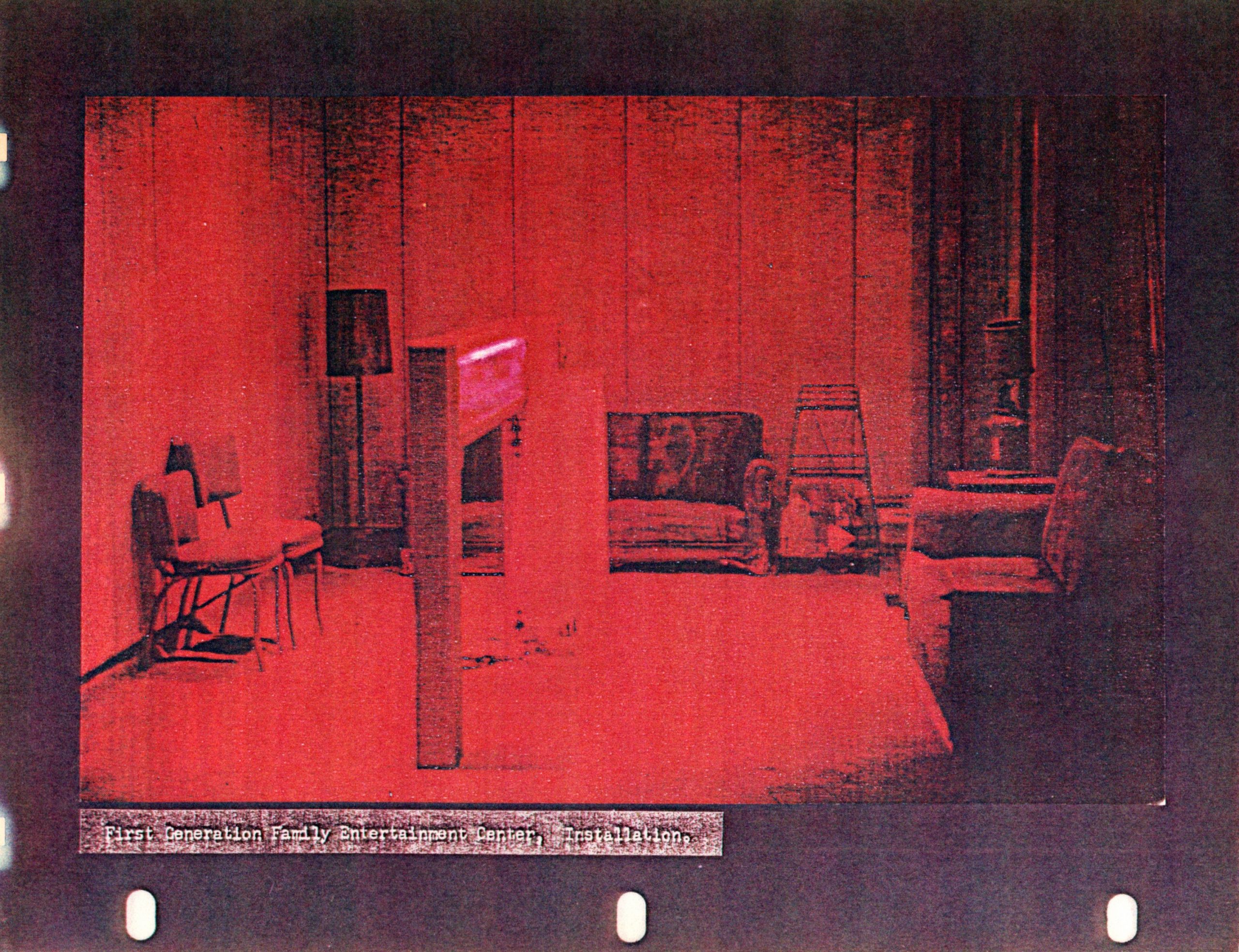
Ultimately, the Entertainment Center makes promises it cannot keep. The viewer, wanting to join in, to participate, is barricaded out, tantalized by the sounds of others’ collective pleasure, left wanting by hypnotic abstraction. Both the Emergency Nature Supply Kit and Early Warning System threaten impending doom, but they also exaggerate the meager solutions supplied by the commodity form. The Specimen Viewers dazzle with an enticement to see “scientifically” but are revealed to only offer unenhanced aesthetic contemplation. The Art Tools and Erosion Machines make overly laborious overtures to create paintings of underwhelming, accumulated gobs of paint or sculptures of slumping, eroded sediment. In each, the works broadcast inefficiency and theatricalize excess expenditure of both labor and time. Ngai crucially interrogates whether “those whose labor power is structurally devalued, or whose ability to sell it is more precarious”—that is, those marked by gender and race—may be “more likely to call out the gimmick.” If so, she asks, “is this because they are more exposed to its dangers?”41 The ultimate gimmick is perhaps racial capitalism itself.
In Cheng’s archives, a typescript page regarding Early Warning System cautions a potential purchaser that “like all electronic and electrical systems produced by Man, The Model 3F-C163 is subject to occasional breakdown due to bulb failure, etc.”42 On the same page, the artist takes on the role of “serviceman,” who can be called upon to install or fix the object, figuring the artist as a contractual laborer, a provisioner of not only objects made but also services rendered—at once necessary and superfluous, the maintainer of systems that will fall apart.
Machines inevitably break. Those Cheng made under the auspices of the John Doe Company in the late 1960s and early 1970s seem to have been designed to refuse the conditions of “working” properly in the first place.43 They are object lessons in planned obsolescence, but they are also microcosms of what, in the common parlance, might be described as the “broken systems” that characterize life in late capitalism, its harms meted out asymmetrically through modalities lived as gender and race. Cheng’s work thus provides a different account of art made after modernism than its hegemonically white articulation. To consider his work in relation to the conditions of his time is not, then, merely an additive or assimilationist process—demonstrating the similitude between his works and the Minimalist, post-Minimalist, and institution-critical works of the period—but rather an attempt to renovate the terms of analysis and to contest the categories themselves.44

Ultimately, for Lowe and for the present analysis, Asian American “formal deviations” cannot be “simply assimilated” into extant accounts of either modernism or postmodernism, precisely because of the “specific conditions of [Asian American] racialization in relation to modern institutions.”45 Economic efficiency—working—is one such site of racialization. The question is: For whom could the fantasy of art’s collusion with industry—its ever-heightening investments in efficiency and efficacy—seem desirable in the first place? That question is haunted by its correlate: For whom could the idea of art as an alternative, untethered from political economy, ever seem a reprieve? Cheng’s work queries the relationship between the realms of technological industry and art not to assume the authority of the former, or to reinscribe the latter into a modernist dream of pure autonomy, but rather to render both inoperative. As our discipline turns its eye to reparative, revisionist histories, Cheng’s work not only deserves its own careful attention but might also spur art-historical inquiry that acknowledges that processes of racialization and racisms are never only exclusionary but also, at the same time, always already extractive.
Machines erode and natural resources are finite. So too is labor-power continuously withdrawn from the market by wear and tear, physical deterioration, and, ultimately, premature death.46 Labor-power requires replacement, Marx tells us; “since more is expended, more must be received.”47 Cheng’s Supply & Demand stages these grisly realities (1972; fig. 18). It houses, in one chamber, a number of flies, only to transport them pitilessly into the maw of a Venus flytrap awaiting its meal in the next. With its lights and knobs, this seemingly complex device is, in the end, little more than a feeding chute, a grim joke (procedurally related but tonally divergent from Hans Haacke’s Rhinewater Purification Plant, also 1972).48 When I first encountered this work, I read in it a tidy model of what Marxist theorists call secular crisis: capital requires not only expanded reproduction, but also accumulation, and secular crisis describes “the long-term tendency of capital to exhaust and expel the very resources it requires to endure.”49 The system cannot sustain itself indefinitely, I thought, at some point, more flies would need to be procured.

Cheng told me a different story: in one early installation of Supply & Demand, he placed a breeder of aphids in the first chamber (fig. 19). Unruly subjects, they escaped their Plexiglas enclosure and made their way into another segment of the machine.50 Over the course of the exhibition they ate through tubes channeling water to the plant, and ultimately, found their way to the carnivorous organism’s roots, roots on which they, rather than be eaten, began to gnaw. Some would call it a failed experiment—others, revolt.
Cite this article: Catherine Damman, “Art, Technology, Crisis: The Work of Carl Cheng,” Panorama: Journal of the Association of Historians of American Art 7, no. 1 (Spring 2021), https://doi.org/10.24926/24716839.11480.
PDF: Damman, Art, Technology, Crisis
Notes
- Sianne Ngai, “Introduction,” in Ugly Feelings (Cambridge, MA: Harvard University Press, 2005), 2. Emphasis in the original. Ngai quotes from Theodor W. Adorno, Aesthetic Theory, ed. and trans. Robert Hullot-Kentor (Minneapolis: University of Minnesota Press, 1997), 31. ↵
- Formal and conceptual experiments with portability and enclosure are common threads in the history of twentieth-century art, from Marcel Duchamp’s La Boîte-en-valise, 1935–1941, to the series of Fluxkits masterminded by George Maciunas in the early 1960s, among others. ↵
- Carl Cheng interviewed by Mary Statzer, May 10, 2012, Santa Monica, CA, published in The Photographic Object 1970 (Oakland, CA: University of California Press, 2016), 134–40. Cheng recalls that in the San Fernando Valley at the time there were “only three Chinese families,” 135. ↵
- Michael D. Hall, “Introduction,” in Carl Cheng: John Doe Co. Twenty-Five Year Survey (Santa Barbara, CA: Santa Barbara Contemporary Arts Forum, 1991), 9. Hall’s assessment of the reception of Cheng’s work is hardly an isolated phenomenon; see John R. Williams’s theorization of Asia-as-technê in The Buddha in the Machine: Art, Technology, and the Meeting of East and West (New Haven, CT: Yale University Press, 2014). ↵
- Cheng spent a period at the Folkwang School of Art in Essen, Germany, from 1964 to 1965 and received his MFA at the University of California, Los Angeles in 1967. ↵
- Contra the then-dominant pictorialist tradition, Heinecken described himself as a “para-photographer,” appropriating and recontextualizing images from mass media and incorporating those images into formats such as collage, photograms, and rephotography. Some of Cheng’s earliest works were included alongside those of Heinecken in Photography into Sculpture, a 1970 Museum of Modern Art (MoMA) exhibition curated by Peter Bunnell. See The Photographic Object 1970 (Oakland, CA: University of California Press, 2016). ↵
- Anna C. Chave, “Minimalism and the Rhetoric of Power” (1990) in Art in Modern Culture: An Anthology of Critical Texts, eds. Francis Frascina and Jonathan Harris (New York: HarperCollins, 1992), 25. ↵
- Robert Morris, “Size Matters,” Critical Inquiry 26 (spring 2000): 474–87. Morris’s theatricalizations of physical labor in this period include his performance Site (1964), his Continuous Project Altered Daily (1969) at the Leo Castelli Gallery Uptown, and his 1970 retrospective at the Whitney Museum of American Art. See Julia Bryan-Wilson, “Robert Morris’s Art Strike,” in Art Workers: Radical Practice in the Vietnam War Era (Berkeley: University of California Press, 2009). ↵
- Of Morris’s machismo, Bryan Wilson makes a brief parenthetical to note the invocations of “working class culture, which is implicitly gendered ( . . . and racially coded white).” See Bryan Wilson, Art Workers, 89. ↵
- Lisa Lowe, Immigrant Acts (Durham, NC: Duke University Press, 1996), 28. ↵
- Colleen Lye, America’s Asia: Racial Form and American Literature, 1893–1945 (Princeton, NJ: Princeton University Press, 2005), 5. ↵
- Lowe, Immigrant Acts, 5. ↵
- See Jack Burnham, “Systems Esthetics” in Great Western Salt Works: Essays on the Meaning of Post-Formalist Art (New York: George Braziller, 1974); John Beck and Ryan Bishop, Technocrats of the Imagination: Art, Technology, and the Military-Industrial Complex (Durham, NC: Duke University Press, 2020); 9 Evenings: Theater and Engineering, eds. Pontus Hultén and Frank Königsberg (New York: E.A.T., 1966); 9 Evenings Reconsidered: Art, Theatre, and Engineering 1966, ed. Catherine Morris, exh. cat. (Cambridge, MA: MIT List Visual Arts Center, 2006); and Michelle Kuo, “‘To Avoid the Waste of a Cultural Revolution’: Experiments in Art and Technology” (PhD diss., Harvard University, 2018). ↵
- See “Experiments in Art and Technology,” Pavilion, eds. Billy Klüver, Julie Martin, and Barbara Rose (New York: Dutton, 1972); and Hiroko Ikegami, “‘World Without Boundaries?’ E.A.T. and the Pepsi Pavilion at Expo ’70, Osaka,” Review of Japanese Culture and Society 23 (December 2011): 174–90. ↵
- Maurice Tuchman conceived of the project in 1966, and it formally ran from 1967 to 1971. See Maurice Tuchman, Art & Technology: A Report on the Art & Technology Program of the Los Angeles County Museum of Art, 1967–1971 (Los Angeles: Los Angeles County Museum of art, 1971). ↵
- Carl Cheng, interview by Betty Klausner in Carl Cheng: John Doe Co. Twenty-Five Year Survey (Santa Barbara, CA: Santa Barbara Contemporary Arts Forum, 1991), 9. ↵
- Carl Cheng, conversation with the author, January 26, 2021. ↵
- Cheng first conceived of the idea in 1966, formally began using the name in 1967, and received a business license for John Doe Company in 1970. ↵
- In 1874, when the group of artists later known as the Impressionists opened their exhibition at the photographer Nadar’s photography studio, they called themselves Societé Anonyme cooperative d’artistes peintres, sculpteurs, graveurs, etc, essentially a means of “incorporating” themselves. One might also consider projects more contemporaneous to Cheng’s, such as the Canadian collective N.E. Thing Co (Iain and Ingrid Baxter) or Allen Ruppersberg’s Los Angeles-based projects Al’s Café (1969), and Al’s Grand Hotel (1971). ↵
- Esther Robles Gallery was among the first to open on La Cienega Boulevard, which at the time was the center of the Los Angeles art world, exerting a gravitational pull. The area’s significance had been established by the storied Ferus Gallery (1957–66) and the Artforum offices, which were located in the space above Ferus from 1965 until they relocated to New York in 1967. Esther Robles Gallery records, 1947–86. Archives of American Art, Smithsonian Institution, Washington, DC. ↵
- Submerging his Asian surname may have also been an exigent choice amid heightened anti-Asian sentiment during the Vietnam War era. ↵
- Benjamin H. D. Buchloh, “Conceptual Art 1962–1969: From the Aesthetic of Administration to the Critique of Institutions,” October 55 (Winter 1990): 105–43. Alexander Alberro, Conceptual Art and the Politics of Publicity (Cambridge, MA: MIT Press, 2003). ↵
- Robert Heinecken’s works from this period employ similar devices, such as his reconstituted Time magazines imprinted with pornographic images taken from Cavalcade. See Robert Heinecken: Object Matter, exh. cat. (New York: Museum of Modern Art, 2014). ↵
- Rachel Rivenc, Made in Los Angeles: Materials, Process, and the Birth of West Coast Minimalism (Los Angeles: Getty Conservation Institute, 2016). ↵
- Rosalind Krauss, “Allusion and Illusion in Donald Judd,” Artforum 4, no. 9 (May 1966): 24. ↵
- James J. Gibson, The Senses Considered as Perceptual Systems (Boston: Houghton Mifflin, 1966). ↵
- Robert Smithson, interview by Bruce Kurtz in “Conversation with Robert Smithson on April 22nd, 1972,” in The Writings of Robert Smithson, ed. Nancy Holt (New York: New York University Press, 1979), 200. Quoted in Craig Owens, “From Work to Frame, Or, Is There Life After ‘The Death of the Author?’” in Beyond Recognition: Representation, Power, and Culture, ed. Scott Bryson (Berkeley: University of California Press, 1994), 122. ↵
- Carl Cheng Archives, 1968–70 Project Files. Private Collection. Santa Monica, CA. Cheng undertook this project in collaboration with the artist Masami Teraoka. ↵
- Such works include Natural Museum of Modern Art (1979), which was installed along the boardwalk in Santa Monica. In different iterations, First Generation Family Entertainment Center was also briefly coin-operated. ↵
- Cheng, conversation with the author, 2021. ↵
- See Anti-Illusion: Procedures/Materials, exh. cat. (New York: Whitney Museum of American Art, 1969); and Robert Pincus-Witten, Postminimalism (New York: Out of London Press, 1977). ↵
- Sianne Ngai, Theory of the Gimmick: Aesthetic Judgment and Capitalist Form (Cambridge, MA: Harvard University Press, 2020). ↵
- In their distinctive hues and emphasis on physical degradation, Cheng’s Erosion Machines will remind many viewers of Paul Thek’s own indelible riffs on the Minimalist cube or vitrine: the untitled works he began exhibiting in 1964 and the ensuing Technological Reliquaries series. ↵
- Ngai, Theory of the Gimmick, 1. ↵
- Ngai, Theory of the Gimmick, 48. ↵
- Kate Conger, “‘Master,’ ‘Slave’ and the Fight Over Offensive Terms in Computing,” New York Times, April 13, 2021, https://www.nytimes.com/2021/04/13/technology/racist-computer-engineering-terms-ietf.html. ↵
- Michel Foucault, The Birth of Biopolitics: Lectures at the Collège de France, 1978–79, ed. Michel Senellart, trans. Graham Burchell (New York: Palgrave Macmillan, 2008); Achille Mbembe, “Necropolitics,” Public Culture 15, no. 1 (winter 2003): 11–40; and Mbembe, Necropolitics (Durham, NC: Duke University Press, 2019). ↵
- “The ‘Art and Technology’ Exhibition at Los Angeles County Museum (Two Views): Jack Burnham, ‘Corporate Art,’ and Max Kozloff, ‘The Multimillion Dollar Art Boondoggle,’” Artforum 10, no. 2 (October 1971): 72–76. Serra’s quotation is drawn from the published statements accompanying his A&T commissioned work, Five Plates, Two Poles (1971), produced in collaboration with the Kaiser Steel Corporation. Quoted in James Merle Thomas, review of From the Archives: Art and Technology at LACMA, 1967–1971, Los Angeles County Museum of Art, CAA Reviews, June 9, 2016, https://doi.org/10.3202/caa.reviews.2016.73. ↵
- Jack Burnham, “Art and Technology: The Panacea That Failed,” in Myths of Information: Technology and Postindustrial Culture, ed. Kathleen Woodward (Madison, WI: Coda, 1980), 200–15. ↵
- Cheng, conversation with the author, April 22, 2021. ↵
- Ngai, Theory of the Gimmick, 17. Ngai describes the contradiction wherein race and gender are at once “written off as peripheral” and intensely necessary, with ascriptive categories of difference offered up as solutions: “capitalist ‘fixes,” whose effect is “lowering the value of labor power and intensifying rifts among the exploited.” ↵
- Typescript document describing features of Early Warning System Model No CF 163-01, Carl Cheng Archives, 1968–70 Project Files. ↵
- Here I draw on Helen Molesworth’s analysis of Duchamp’s readymades as likewise “antifunctional,” as in Trébuchet (1917), a coatrack nailed inconveniently to the floor. In Duchamp’s studio, such everyday objects resisted their “intended, mandated, standardized use,” thwarting domestic labor in a “private rebellion” that Molesworth likens to Taylorist soldiering, work slowdowns that resist factory demands for productivity in a manner related to, but distinct from, total organized stoppages like the strike. Helen Molesworth, “Work Avoidance: The Everyday Life of Marcel Duchamp’s Readymades,” Art Journal 57, no. 4 (Winter 1998): 58–60. ↵
- See also Susette Min, Unnamable: The Ends of Asian American Art (New York: New York University Press, 2018). ↵
- Lowe, Immigrant Acts, 32. ↵
- My phrasing here is a deliberate echo of Ruth Wilson Gilmore’s well-known definition of racism: “The state-sanctioned or extralegal production and exploitation of group-differentiated vulnerability to premature death in distinct yet densely interconnected political geographies.” Ruth Wilson Gilmore, The Golden Gulag: Prisons, Surplus, Crisis, and Opposition in Globalizing California (Berkeley: University of California Press, 2007), 27. ↵
- Karl Marx, “The Sale and Purchase of Labor Power,” in Capital: A Critique of Political Economy, trans. Ben Fowkes (New York: Penguin, 1976), 1: 275. As Sara Ahmed writes, “A history of being used up is the history of racial capitalism.” Sara Ahmed, “The Biology of Use and Disuse,” in What’s the Use? On the Uses of Use (Durham: Duke University Press, 2019), 95. ↵
- In this, Cheng’s work is again conversant with, but notably distinct from, other artists’ work with systems and ecologies in this period. See, for example, Luke Skrebowski, “All Systems Go: Recovering Hans Haacke’s Systems Art,” Grey Room 30 (Winter 2008): 54–83; James Nisbet, Ecologies, Environments, and Energy Systems in the Art of the 1960s and 1970s (Cambridge, MA: MIT Press, 2014); and T.J. Demos, Decolonizing Nature: Contemporary Art and the Politics of Ecology (Berlin: Sternberg Press, 2016). ↵
- Joshua Clover, Sarah Brouillete, and Annie McClanahan, “Introduction: Late, Autumnal, Immiserating, Terminal,” Theory & Event 22, no. 2 (2019): 325. ↵
- Cheng, conversation with the author, April 22, 2021. ↵
About the Author(s): Catherine Damman is Visiting Assistant Professor of Art History at Wesleyan University

